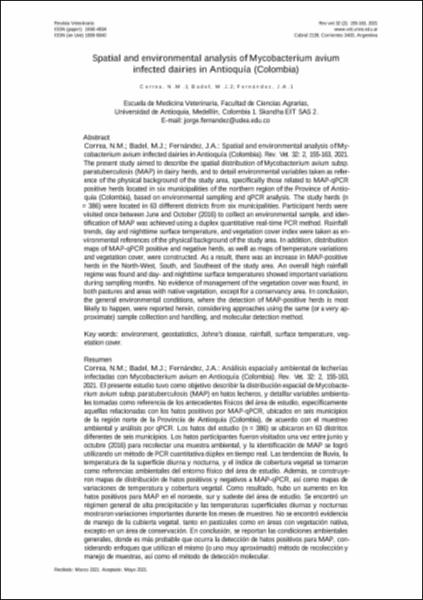Mostrar el registro sencillo del ítem
Análisis espacial y ambiental de lecherías infectadas con mycobacterium avium en Antioquía (Colombia)
Spatial and environmental analysis of mycobacterium avium infected dairies in Antioquía (Colombia)
| dc.contributor.author | Correa, N. M. | |
| dc.contributor.author | Badel, M. J. | |
| dc.contributor.author | Fernández, J. A. | |
| dc.date.accessioned | 2022-07-12T20:58:41Z | |
| dc.date.available | 2022-07-12T20:58:41Z | |
| dc.date.issued | 2021-12-01 | |
| dc.identifier.citation | Correa, N. M., Badel, M. J., Fernández, J. A., 2021. Análisis espacial y ambiental de lecherías infectadas con mycobacterium avium en Antioquía (Colombia). Revista Veterinaria. Corrientes: Universidad Nacional del Nordeste. Facultad de Ciencias Veterinarias, vol. 32, no. 2, p. 155-163. ISSN 1669-6840. http://dx.doi.org/10.30972/vet.3225724 | |
| dc.identifier.issn | 1668-4834 | |
| dc.identifier.uri | http://repositorio.unne.edu.ar/handle/123456789/49181 | |
| dc.description.abstract | El presente estudio tuvo como objetivo describir la distribución espacial de Mycobacterium avium subsp. paratuberculosis (MAP) en hatos lecheros, y detallar variables ambientales tomadas como referencia de los antecedentes físicos del área de estudio, específicamente aquellas relacionadas con los hatos positivos por MAP-qPCR, ubicados en seis municipios de la región norte de la Provincia de Antioquia (Colombia), de acuerdo con el muestreo ambiental y análisis por qPCR. Los hatos del estudio (n = 386) se ubicaron en 63 distritos diferentes de seis municipios. Los hatos participantes fueron visitados una vez entre junio y octubre (2016) para recolectar una muestra ambiental, y la identificación de MAP se logró utilizando un método de PCR cuantitativa dúplex en tiempo real. Las tendencias de lluvia, la temperatura de la superficie diurna y nocturna, y el índice de cobertura vegetal se tomaron como referencias ambientales del entorno físico del área de estudio. Además, se construyeron mapas de distribución de hatos positivos y negativos a MAP-qPCR, así como mapas de variaciones de temperatura y cobertura vegetal. Como resultado, hubo un aumento en los hatos positivos para MAP en el noroeste, sur y sudeste del área de estudio. Se encontró un régimen general de alta precipitación y las temperaturas superficiales diurnas y nocturnas mostraron variaciones importantes durante los meses de muestreo. No se encontró evidencia de manejo de la cubierta vegetal, tanto en pastizales como en áreas con vegetación nativa, excepto en un área de conservación. En conclusión, se reportan las condiciones ambientales generales, donde es más probable que ocurra la detección de hatos positivos para MAP, considerando enfoques que utilizan el mismo (o uno muy aproximado) método de recolección y manejo de muestras, así como el método de detección molecular. | es |
| dc.description.abstract | The present study aimed to describe the spatial distribution of Mycobacterium avium subsp. paratuberculosis (MAP) in dairy herds, and to detail environmental variables taken as refer- ence of the physical background of the study area, specifically those related to MAP-qPCR positive herds located in six municipalities of the northern region of the Province of Antioquia (Colombia), based on environmental sampling and qPCR analysis. The study herds (n = 386) were located in 63 different districts from six municipalities. Participant herds were visited once between June and October (2016) to collect an environmental sample, and iden- tification of MAP was achieved using a duplex quantitative real-time PCR method. Rainfall trends, day and nighttime surface temperature, and vegetation cover index were taken as environmental references of the physical background of the study area. In addition, distribution maps of MAP-qPCR positive and negative herds, as well as maps of temperature variations and vegetation cover, were constructed. As a result, there was an increase in MAP-positive herds in the North-West, South, and Southeast of the study area. An overall high rainfall regime was found and day- and nighttime surface temperatures showed important variations during sampling months. No evidence of management of the vegetation cover was found, in both pastures and areas with native vegetation, except for a conservancy area. In conclusion, the general environmental conditions, where the detection of MAP-positive herds is most likely to happen, were reported herein, considering approaches using the same (or a very ap- proximate) sample collection and handling, and molecular detection method. | en |
| dc.format | application/pdf | |
| dc.format.extent | p. 155-163 | |
| dc.language | spa | |
| dc.publisher | Universidad Nacional del Nordeste. Facultad de Ciencias Veterinarias | es |
| dc.publisher | Revista Veterinaria | es |
| dc.relation.uri | https://revistas.unne.edu.ar/index.php/vet/article/view/5724 | |
| dc.relation.uri | http://dx.doi.org/10.30972/vet.3225724 | |
| dc.rights | openAccess | es |
| dc.rights.uri | http://creativecommons.org/licenses/by-nc-nd/2.5/ar/ | es |
| dc.source | Revista Veterinaria, 2021, vol. 32, no. 2, p. 155-163. | es |
| dc.subject | Cubierta vegetal | es |
| dc.subject | Enfermedad de Johne | es |
| dc.subject | Geoestadística | es |
| dc.subject | Lluvia | es |
| dc.subject | Medio ambiente | es |
| dc.subject | Temperatura superficial | es |
| dc.subject | Environment | en |
| dc.subject | Geostatistics | en |
| dc.subject | Johne’s disease | en |
| dc.subject | Rainfall | en |
| dc.subject | Surface temperature | en |
| dc.subject | Vegetation cover | en |
| dc.title | Análisis espacial y ambiental de lecherías infectadas con mycobacterium avium en Antioquía (Colombia) | es |
| dc.title | Spatial and environmental analysis of mycobacterium avium infected dairies in Antioquía (Colombia) | en |
| dc.type | Artículo | |
| unne.affiliation | Fil: Correa, N. M. Universidad Nacional del Nordeste. Facultad de Ciencias Exactas y Naturales; Argentina. | |
| unne.affiliation | Fil: Badel, M. J. Skandha EIT SAS; Colombia. | |
| unne.affiliation | Fil: Fernández, J. A. Universidad de Antioquia. Facultad de Ciencias Agrarias; Colombia. | |
| unne.journal.pais | Argentina | |
| unne.journal.ciudad | Corrientes | |
| unne.journal.volume | vol. 32 | |
| unne.journal.number | no. 2 | |
| unne.ISSN-e | 1669-6840 |
Ficheros en el ítem
Este ítem aparece en la(s) siguiente(s) colección(ones)
-
Artículos de revista [443]





